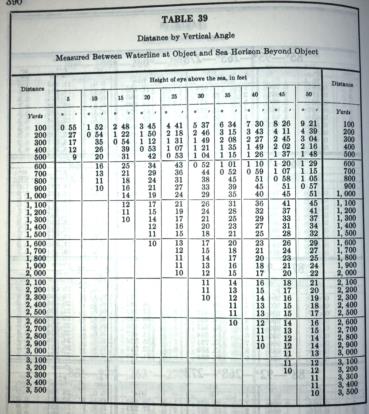
NavList:
A Community Devoted to the Preservation and Practice of Celestial Navigation and Other Methods of Traditional Wayfinding
From: Robert VanderPol II
Date: 2019 Jul 2, 17:26 -0700
Uses table #39 from Vol-II of HO-9, 1984.
Works better for nearer objects, hundreds of yards to 1 NM depending on height of eye.
The higher the better and the longer the range. With a 10' height of eye range tops out at 900y The difference between 800y and 900y is 1' of arc which is how maximum range is defined in this table, 1' difference between successive ranges. As range decreases from maximum accuracy improves.
If you can get your height of eye up to 20' then range is about 1600y.
25' gets you 2000y or about 1 NM.
100' HoE gets you about 5,000y so the law a diminishing returns bites fairly quickly.
If you have rat lines or mast steps you should be able to get your eye to 20' or 25' at the lower spreaders unless you have a very small boat like mine.
Re: What makes man a Navigator?
From: Herman Dekker
Date: 2019 Jul 2, 02:31 -0700
Hello Robert,
Your Quote:
Did you know that you can obtain range to another vessel by measuring the angle between it's waterline and the horizon beyond?
You only need to know your own height of eye, nothing about the vessel's or landmark's dimensions. Yet another sextant use.How does this work and how accurate is it?
regards,
HermanD







